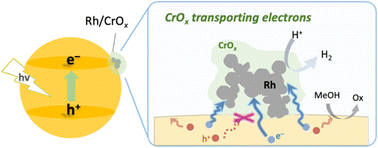An unexplored role of the CrOx shell in an elaborated Rh/CrOx core–shell cocatalyst for photocatalytic water splitting: a selective electron transport pathway from semiconductors to core metals, boosting charge separation and H2 evolution†
Abstract
A core–shell structured Rh/CrOx cocatalyst has endowed various semiconductors with high efficiency in water-splitting photocatalysis, where thin CrOx layers on Rh have been assumed to be physical blockers of O2 to the metal surface to suppress unfavorable reverse reactions (e.g., catalytic H2O formation from H2 and O2). Herein, we propose another unexplored but favorable function of CrOx layers: a selective electron transport pathway from photocatalysts to the Rh core boosting charge separation and H2 production. The subsequent loading of CrOx layers onto Rh increased the rate of visible light H2 evolution of a Bi4NbO8Cl photocatalyst, even in a half reaction with a hole scavenger where O2 does not evolve. Transient absorption spectroscopy revealed that the CrOx layer increases the electron path from Bi4NbO8Cl to Rh. Importantly, the highest H2-evolution activity was obtained by simultaneous photodeposition using CrIII and RhIII precursors, which had not yet been examined. In this sample, Rh nanoparticles were enclosed by an amorphous CrOx shell, where Rh particles were less directly attached to the semiconductor. Therein, CrOx inserted between Bi4NbO8Cl and Rh effectively suppresses undesirable hole transfer from Bi4NbO8Cl to Rh, while such hole transfer partially occurs when they are in direct contact. These results indicated that CrOx functions as a selective electron transport pathway and improves the H2 evolution activity. Although the development strategy of cocatalysts has so far focused on surface redox reactions, this study offers a new approach for the design of highly efficient cocatalysts based on the carrier transfer process, especially at semiconductor–cocatalyst interfaces.

- This article is part of the themed collection: Hydrogen production


 Please wait while we load your content...
Please wait while we load your content...